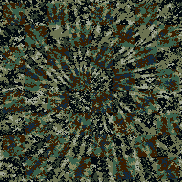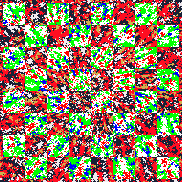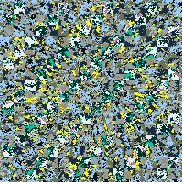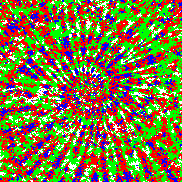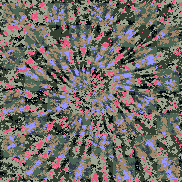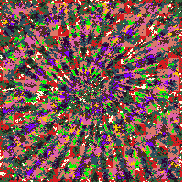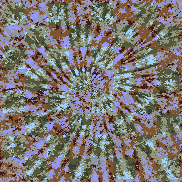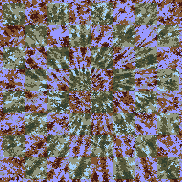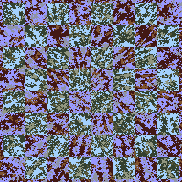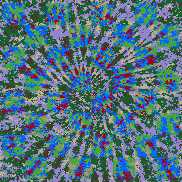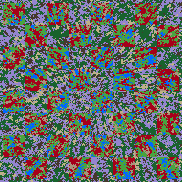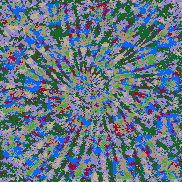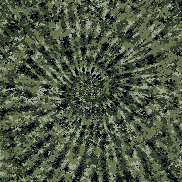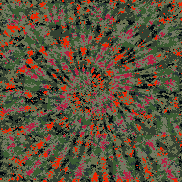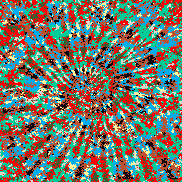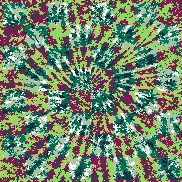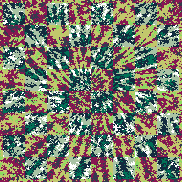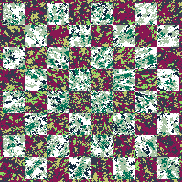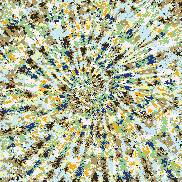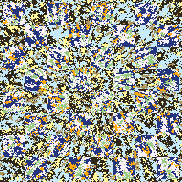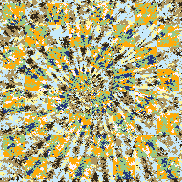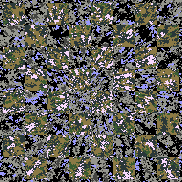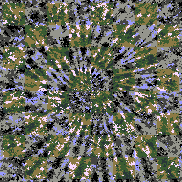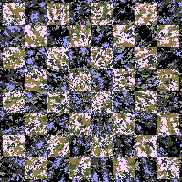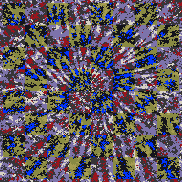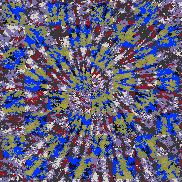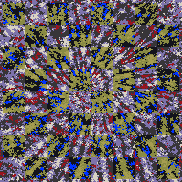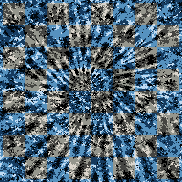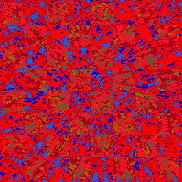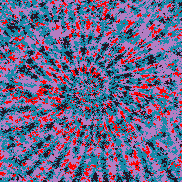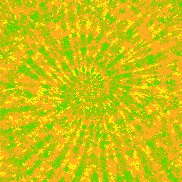Tie-Dye-Camo is a NFT artwork by Dan Ellis consisting of 2023 unique NFTs to be hosted on the Tezos blockchain. These 2023 NFTs are the result of a lengthy curation of hundreds of thousands of generated svgs, centered around a rarity structure, primarily organized around 4, 8 and 12 color permutations. The final works are png files, each with unique color combinations and characteristics spanning 9 traits to create a complete cohesive collection. All works are identical in underlying line-composition, but are radically differentiated by the sequence of color permutations, some resembling a Tie-Dye design, others a Chess board, and others non-representational abstraction. No two are identical.
NFT ID
A number 1–2023 assigned to each NFT in this collection.
Style
Each NFT is assigned a specific style trait based off appearance.
Tie-Dye: Tie-Dye is assigned to 90.1% of works in the collection and are easily recognizable by there spiral depiction which references the DIY garment dye-technique popularized in the 1960s American hippie movement. Spanning the entire collection, Tie-Dye pieces can be either 4, 8 or 12 color, ranging from 1-5 color permutations.
Chess: The style of Chess is assigned to NFTs that resemble the chess board. All of these works contain 8 colors and account for 3.7% of the collection. Chess style works are always paired with 1 or 2 permutations.
Abstract: Abstract NFTs can be detected because they are neither chess nor tie-dye design. These are a composition of colors with no apparent objective representation. They can either be 12 or 8 color works, ranging from 1-3 permutations, and accounting for 6.2% of the collection.
Color-Count
Each NFT is comprised of 4 colors, 8 colors or 12 colors.
4 Colors: 4 Color NFTs make up the majority of works in the Tie-Dye-Camo collection, accounting for 64% of the total artworks. They are the heart of this project, from which the other color-count categories are derived.
8 Colors: 8 Color NFTs account for 33% of the works in the collection. They were designed to explore what would happen if the original color-count of 4 doubled. Would the Tie-Dye spiral continue to be seen if additional colors violently broke the pattern? Pleasantly, the answer is yes. In addition, to expanding the diversity of the Tie-Dye-Camo works, additional styles of Chess and Abstract were subsequently unearthed.
12 Colors: 12 color NFTs are the rarest color-count in the collection, occupying 3% of the total collection count. Continuing the logic explained in the 8 color works, the same exploration was applied to the discovery of the 12 color variety. Advanced color interactions were very difficult to find. 12 colors can interact 479,001,600 unique ways. To help discover successful color-ways, 12 Color works were summarily derived from the already exhaustive discovery of successful 4 and 8 color combinations.
Permutations
A permutation is way in which a set of numbers can be ordered or arranged. In this case a permutation represents a unique way in which 4, 8 or 12 colors can be ordered. Each NFT, contains a unique combination of colors. NFTs of the exact same color values and color-count, expressed in different orders, are identified by the same Group ID (1 of 703 groups). Each group contains 1-5 permutations of the same color-set. The above example, of 3 permutations, belong to Group ID 123. Each NFT in this group contain the exact same colors, arranged in a different order. Across the collection, each Tie-Dye-Camo NFT has been hand-selected, by the artist, from either 24 permutations for the 4 color works, 576 permutations for the 8 color works, or 13,824 permutations for the 12 color works.
Permutations of 5 account for 29.2% of the collection.
Permutations of 4: 20.6%
Permutations of 3: 26.7%
Permutations of 2: 17.3%
Permutations of 1: 6.2%
Group ID
A Group ID is a number assigned to each NFT permutation containing the same colors and color-count. Groups contain 1 to 5 permutations. In total there are 703 Groups. The above is an example of NFTs belonging to Group ID: 331, which contains 3 permutations. Note: Group-IDs are not a documented 'attribute' per each token, rather they are noted in the token's tags.
Color-Type
There are 3 different Color-types in the Tie-Dye-Camo collection: Camo, CamoBloom and Assorted.
Camo: Tie-Dye-Camo was originally conceived in an effort to combine traditional camouflage colors, pixelated in a MARPAT inspired design, with a Tie-Dye resemblance. The Camo Color-type is the result of this effort. This wide ranging palette of low saturated colors spans from desert to sea to forrest, snow, night, urban, etc. Palettes were selected from a survey of military uniforms past and present spanning the globe. Camo Color-types contain either 4 or 8 colors. Color-types of Camo designation account for 16.2% of the entire collection.
CamoBloom: CamoBloom NFTs were created to abstractly represent trees in bloom, combining camo colors with floral palettes. If one could envision a world moving away from military conflict, spring seems to be an adequate metaphor. This representation of trees or fields in-bloom is designed to express respect for the sacrifices of all men and women, in many uniforms, across lines have made, in a similar quest for the improved human condition. At a grounding level, most share a respect for beauty, so delicately exemplified in a flower and the weathered trees that protect and allow its growth. CamoBloom Color-types contain either 4 or 8 colors. Color-types of CamoBloom designation account for 11.1% of the entire collection.
Assorted: NFTs not belonging to the Camo or CamoBloom Color-types, by default belong to the Assorted Color-type. Assorted Color-types contain either 4, 8, or 12 colors. This Color-type ranges from the wildly expressive to the soft-spoken and account for 72.7% of the collection.
Relatives
Some NFTs are more rare because they contain either a Chess or Abstract NFT in their Group. This technique was invented to call attention to groups of note.
Relatives: Has Chess
Has Chess: NFT Groups that contain a Chess style NFT account for 8.8% of the collection. They range from 2-3 permutations per group, all 8 color works.
Relatives: Has Abstract
Has Abstract: NFT Groups that contain an Abstract style NFT account for 11.1% of the collection. They range from 1-3 permutations per group and are either 12 or 8 color works.
Relatives: Has Both
Has Both: NFT Groups that contain an Abstract style NFT and a Chess style NFT account for 0.9% of the collection. They all contain 3 permutations per group (1 Abstract, 1 Chess, and 1 Tie-Dye) and are all 8 color works.
Relatives: Has Neither
Has Neither: NFT Groups that contain neither an Abstract style NFT nor a Chess style NFT account for the majority of the collection at 79.2%. They range from 1-5 permutations, spanning 4, 8 and 12 color works.
Saturation-Sum
Saturation-Sum: Saturation-Sum is a rating of 1-20 assigned to each NFT based on the sum of each NFTs' colors' saturation values. NFTs with the highest Saturation-Sum are the rarest and receive the rating of 20, accounting for 3.6% of the collection. NFTs with the lowest Saturation-Sum receive a rating of 01.
Saturation-Brightness
Saturation-Brightness: Saturation-Brightness is a rating of 1-10 calculated by measuring the saturation and brightness of each NFT when reduced to 1px. With a preference for saturation this rating is achieved by multiplying the saturation value by 1.5 and adding it to the brightness value. NFTs are then assigned a scaled rating of 1-10, with 10 being the rarest. NFTs with a Saturation-Brightness rating of 10 consist of the brightest and most saturated NFTs and account for 9.7% of the collection.
Map
As an added feature, a data map has been created to allow users to review the collection as icons that represent trait values. This is a fast way to orient oneself to the rarity structure of the entire collection.
View Map
PFP
Upon review of the Tie-Dye-Camo collection a self-portrait became apparent. This was not planned. I have no idea how this portrait ended up tucked away unnoticed for years... PFPs have been created from each NFT for collectors use across social platforms to express support for this project. PFPs are in addition to the Tie-Dye-Camo NFT and are separate from the metadata recorded on the blockchain.
View PFPs
Project Statement
I created this artwork to merge symbols of 'war' and 'peace' in an effort to picture a daze-like combination of polarities. Where this new symbolic language contiues from here is for people to discover overtime. This is my best attempt at expressing our current paradigm coupled with its representative technology, thus sealing the work in history.
Project History
As mentioned above, The Tie-Dye-Camo project actually began in 2016 with a desire to create an all-over-print garment. The structure of Tie-Dye-Camo was drawn pixel by pixel and progressed in design over a period of 3 years. The sweatshirts were the first manifestation of this endeavor.
Prior to NFTs popularity Boom in early 2021, I had been experimenting with the Scalable Vector Graphic (svg), exploring ways to combine this powerful code-based image language with advancements in the exchange of non-fungible blockchain assets. The result was partially successful as I learned that svg support on different wallets and marketplaces was not entirely consistent. Rather than lead a campaign to push svg integration, I decided to use svg as a means to an end, that end being png files. After cleaning up the svg code for my previously realized 4 color Tie-Dye-Camo design, I began writing code in php to populate this svg 'template' with pre-selected hexidecimal color values and save the resulting files. I learned to become very flexible with php and what started as a challenge to review 24 perumations of svg output files based on input from 4 color values, led me down the road of varied color combination creation, cataloging and review. As the experimentation continued, new color palettes were introduced and I began reviewing files in the 1000s just to see how 1 new color could alter the underlying 3. This color-journey continued for a while and led to experiments increasing in difficulty with 8 colors and finally 12 colors. In order to organize my svg files into a cohesive collection, a rarity structure specific to the strengths of the overall project was worked on and formulated. After the formulation of the basic data traits, svgs were carefully-curated according to their observable strengths and uniqueness in color and ultimately assigned to fit the desired rarity-data structure. Upon completion, the svg files were converted into their final form of 182 x 182 png files, and their metadata trait-value pairs.

About the Artist
My name is Dan Ellis. I enjoy creating my own style. My love and knowledge of painting and practice of painting using computers, keeps me exciting to the computer cognizant. My love and knowledge of computers informing painting, keeps me exciting to the painting people. Reach out to me if you too can see a future in this overlap.
